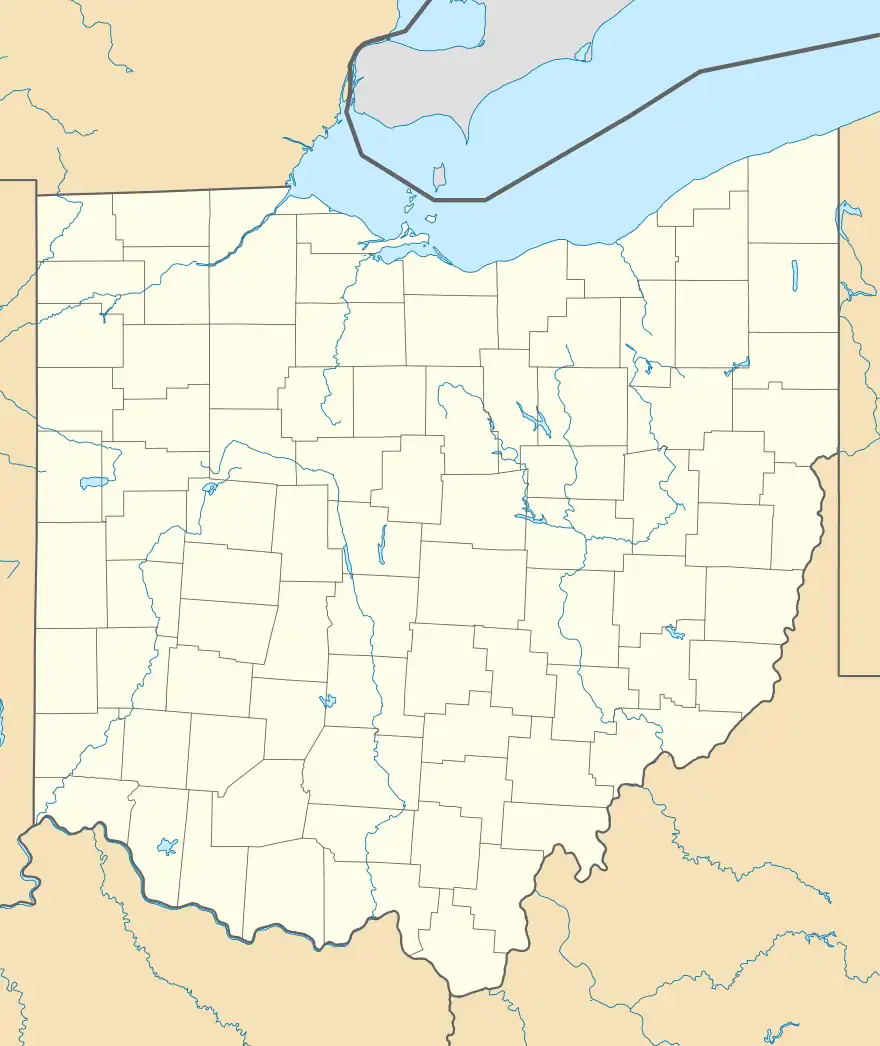McDonald Farm (Xenia, Ohio)
The McDonald Farm is a historic agricultural complex near the city of Xenia in Greene County, Ohio, United States. It has been named a historic site, largely because of a quarry on the farm, which supplied stone for the Washington Monument.
McDonald Farm | |
 A silo and barn at the farm | |
  | |
| Location | 1418 Stone Rd., Xenia, Ohio |
|---|---|
| Coordinates | 39°38′28″N 83°53′0″W |
| Area | 68 acres (28 ha) |
| Built | 1829 |
| Architectural style | Federal, Greek Revival, I-house |
| NRHP reference No. | 96000673[1] |
| Added to NRHP | June 14, 1996 |
Geology
Much of Greene County is underlain by Dayton Limestone, a high-quality limestone whose type locality is in the city of Dayton in the adjacent Montgomery County. Farmers in Greene County supplied building stone for local needs through much of the nineteenth century, and by the late 1870s it was being exported to distant localities by the Dayton and Xenia Railroad.[2]: 380 Wilford McDonald, who lived about 3.5 miles (5.6 km) south of Xenia,[2]: 381 began quarrying limestone from his farm around 1820,[3] after it was exposed by erosion from a nearby small stream. Quarrying revealed limestone deposits as deep as 8 feet (2.4 m) in some places, much of it smoothed by glacial abrasion. The reputation of McDonald's quarry became more prominent than any other source of Greene County limestone;[2]: 381 before concrete became prominent as a building material, McDonald supplied substantial amounts of limestone for Xenia buildings, and some of his stone was transported to farther localities.[4] Eventually, McDonald became known as the supplier of one of Ohio's best limestones. Quarrying continued until 1896, when the stream by the quarry flooded it, although a small amount of stone was quarried in the 1930s. Today, the quarry remains filled with water.[3]
Historic significance
In 1849, each of the United States was asked to supply a block of stone for the construction of the Washington Monument. Because McDonald's quarry was known as one of Ohio's best sources of limestone, state geologists decided to supply a block of McDonald stone, and a Xenia mason produced a block measuring 6 × 3 × 0.75 feet (1.83 × 0.91 × 0.23 m) to be sent to Washington, D.C.,[5] where it was eventually placed in the monument's interior stairway.[3]
In 1996, the McDonald Farm was listed on the National Register of Historic Places,[1] by Margretta Lott Bodewell-Great-Great-Granddaughter of the original owner of the property, qualifying both because of the farm buildings' architecture and because of the farm's place in local history. The architecture of the farm buildings is mixed among multiple architectural styles, including a vernacular I-house and the formal Federal and Greek Revival styles.[6] The historic portion of the farm comprises nine buildings and two sites over an area of 68 acres (28 ha), which is designated a historic district.[1]
References
- "National Register Information System". National Register of Historic Places. National Park Service. July 9, 2010.
- Dills, R.S. History of Greene County, Together with Historic Notes on the Northwest, and the State of Ohio. Dayton: Odell and Mayer, 1881.
- "Ohio Historical Marker Dedicated at McDonald Quarry, Greene County Archived 2013-07-11 at the Wayback Machine". Ohio Geology Summer 1996: 7. Accessed 2013-01-01.
- Broadstone, Michael A. History of Greene County, Ohio: Its People, Industries, and Institutions. Vol. 1. Indianapolis: Bowen, 1918, 66.
- McDonald Stone Quarry Archived 2013-12-24 at the Wayback Machine, Ohio Historical Society, 1995. Accessed 2013-01-01.
- McDonald Farm, Ohio Historical Society, 2007. Accessed 2013-01-01.


